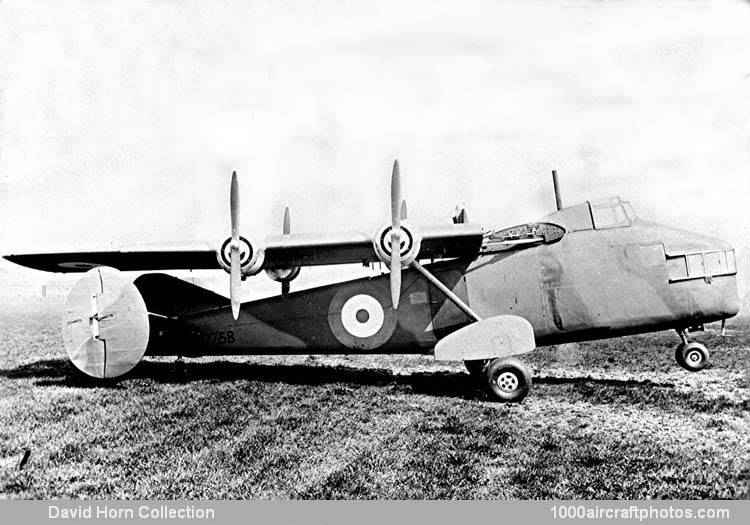Due to development problems with the intended 130 hp Pobjoy Niagara V engine, the first G.A.L. 38 (serial P1758) was fitted with four 90 hp Niagara III engines and was first flown on May 13, 1940. The aircraft showed aerodynamic instability and it underwent major modifications, including a single fin replacing the original three. Although the Royal Navy cancelled the Fleet Shadower project in February 1941, flight testing was resumed in June 1941 with the first prototype, now fitted with the intended four Niagara V engines. Flight testing continued until September 1941, while the unfinished second prototype (serial P1759) was used for spares. P1759 was scrapped in October 1941, P1758 was scrapped in March 1942."
Type: Four-engined carrier-based Fleet Shadower.
Wings: Sesquiplane wing arrangement with the upper wing braced by single forwardly-inclined struts running from the fuselage to the inboard engine nacelle. Lower wing approximately one third of the span of the upper wing. All-wood structure, with spars of compressed wood and plywood, spruce and plywood ribs and an overall covering of plywood. Upper wing fitted with slotted flaps depressing to 40° and slotted ailerons arranged to droop 15° when the flaps were lowered. Fixed wing tip slots ahead of the ailerons. The lower wing fitted with split flaps depressing to 60° and continuous across underside of fuselage. Flap operation by a servo-pneumatic hydraulic unit. Upper wings fold from roots, complete with engine installations. Hydraulic folding.
Fuselage: Rectangular cross-section with rounded corners. All-wood structure comprising spruce and plywood frames, spruce longerons and stringers and a plywood covering.
Tail unit: Cantilever monoplane type. Single fin and rudder. Tail plane and elevators set at slight dihedral. Spruce and plywood spar and ribs, plywood covering. Trim tabs in rudder and elevator.
Landing gear: Fixed tricycle type. Main wheels mounted under lower wing extremities. Oleo suspension. Nose unit fitted with twin wheels, connect to rudder control but could be disconnected in flight. Hydraulic wheel-brakes.
Power plant: Four 130 hp Pobjoy Niagara V seven-cylinder radial air-cooled geared engines driving two-blade fixed-pitch wooden airscrews. Main fuel tanks in fuselage with a hydraulic motor-driven fuel-pump combination for engine feed. Oil tanks in wings.
Accommodation: Crew of three, comprising pilot in enclosed cockpit on top of the fuselage ahead of the main wing and accessible through fuselage; an observer in a glazed compartment in the nose of the fuselage; and a radio operator below and aft of the pilot.
